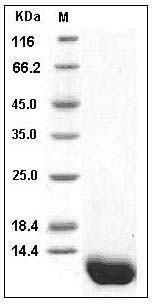-
Product Name
Human Complement C5a recombinant protein
- Documents
-
Description
C5a is a protein fragment released from complement component C5. This 74 amino acid peptide in humans is generated by the cleavage of C5a convertase on the C5 α-chain during the classical, alternative, and lectin pathways of complement activation. The structure of C5a includes a core region consisting of four, anti-parallel alpha-helices held together by three disulfide linkages and a structured C-terminal tail, and C5a is rapidly metabolised by carboxypeptidase B to a 73 amino acid low activity form, C5a des-Arg. C5a is an extremely potent proinflammatory mediator, as well as a potent chemotactic factor for neutrophils and other leukocytes. It causes histamine release, increases in vascular permeability, induces several cytokines production from leukocytes, enhances neutrophil-endothelial cell adhesion, and augments the humoral and cell-mediated immune response. C5a is quickly metabolised by carboxypeptidases, forming the less potent C5adesArg. Acting via a classical G protein-coupled receptor, CD88, C5a and C5adesArg exert a number of effects essential to the innate immune response, while their actions at the more recently discovered non-G protein-coupled receptor, C5L2 (or GPR77), remain unclear. The widespread expression of C5a receptors throughout the body allows C5a to elicit a broad range of effects. Thus, C5a has been found to be a significant pathogenic driver in a number of immuno-inflammatory diseases, making C5a inhibition an attractive therapeutic strategy. C5a is a strong chemoattractant and is involved in the recruitment of inflammatory cells such as neutrophils, eosinophils, monocytes, and T lymphocytes, in activation of phagocytic cells and release of granule-based enzymes and generation of oxidants, all of which may contribute to innate immune functions or tissue damage. Accordingly, the anaphylatoxin C5a is implicated in a variety of diseases such as rheumatoid arthritis, systemic lupus erythematosus, reperfusion injury, Alzheimer's disease, and sepsis.
-
Protein short names
FLJ17816; MGC142298; C5A; CPAMD4; FLJ17822
-
Source/Expression Host
E. coli
-
Expression Plasmid/cDNA
A DNA sequence encoding the active form of human C5a (Leu 679-Arg 751) was expressed.
-
Protein Species
Human
-
Molecular weight
The recombinant human C5a consists of 74 amino acids and has a predicted molecular mass of 8.3 kDa which is also estimated by SDS-PAGE.
-
Purity
> 94 % as determined by SDS-PAGE
-
Activity
Measured by its ability to induce N-acetyl-β-D-glucosaminidase release from differentiated U937 human histiocytic lymphoma cells. The ED50 for this effect is typically 5-15 ng/ml.
-
Validations

Human Complement C5a Protein SDS-PAGE
Related Products / Services
Please note: All products are "FOR RESEARCH USE ONLY AND ARE NOT INTENDED FOR DIAGNOSTIC OR THERAPEUTIC USE"
